HI6028 Taxation Theory, Practice & Law Individual Assignment T2 2017
VerifiedAdded on 2020/02/18
|12
|2782
|200
Homework Assignment
AI Summary
This document presents a comprehensive analysis of a taxation assignment, addressing five distinct case studies within the framework of Australian taxation law. The assignment begins with an evaluation of capital gains and losses arising from asset transactions, applying relevant legal provisions to determine tax liabilities. The second case study focuses on fringe benefits tax (FBT) related to employee loans, calculating taxable values and considering scenarios involving interest payments and waivers. The third case study examines the allocation of rental income and losses between joint tenants, clarifying the application of tax regulations to property ownership arrangements. The fourth case study delves into tax avoidance schemes, referencing the Duke of Westminster principle and its implications. Finally, the fifth case study provides guidance on the taxation of timber disposal, including the application of ruling TR 95/6 to determine assessable income from timber sales. Each case study utilizes the ILAC (Issue, Law, Application, Conclusion) approach to provide structured and well-reasoned solutions, supported by relevant legal provisions and calculations.
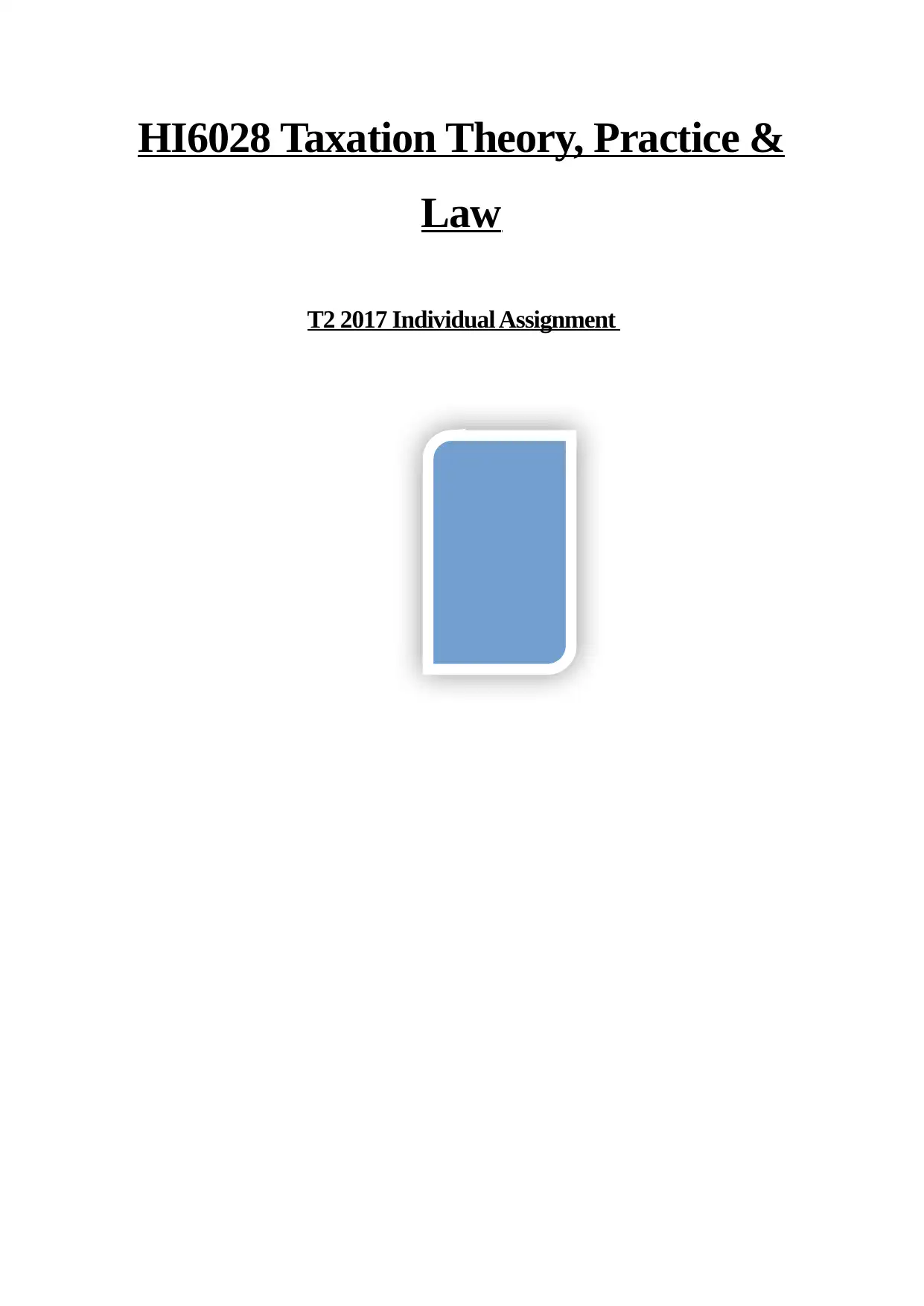
HI6028 Taxation Theory, Practice &
Law
T2 2017 Individual Assignment
Law
T2 2017 Individual Assignment
Paraphrase This Document
Need a fresh take? Get an instant paraphrase of this document with our AI Paraphraser
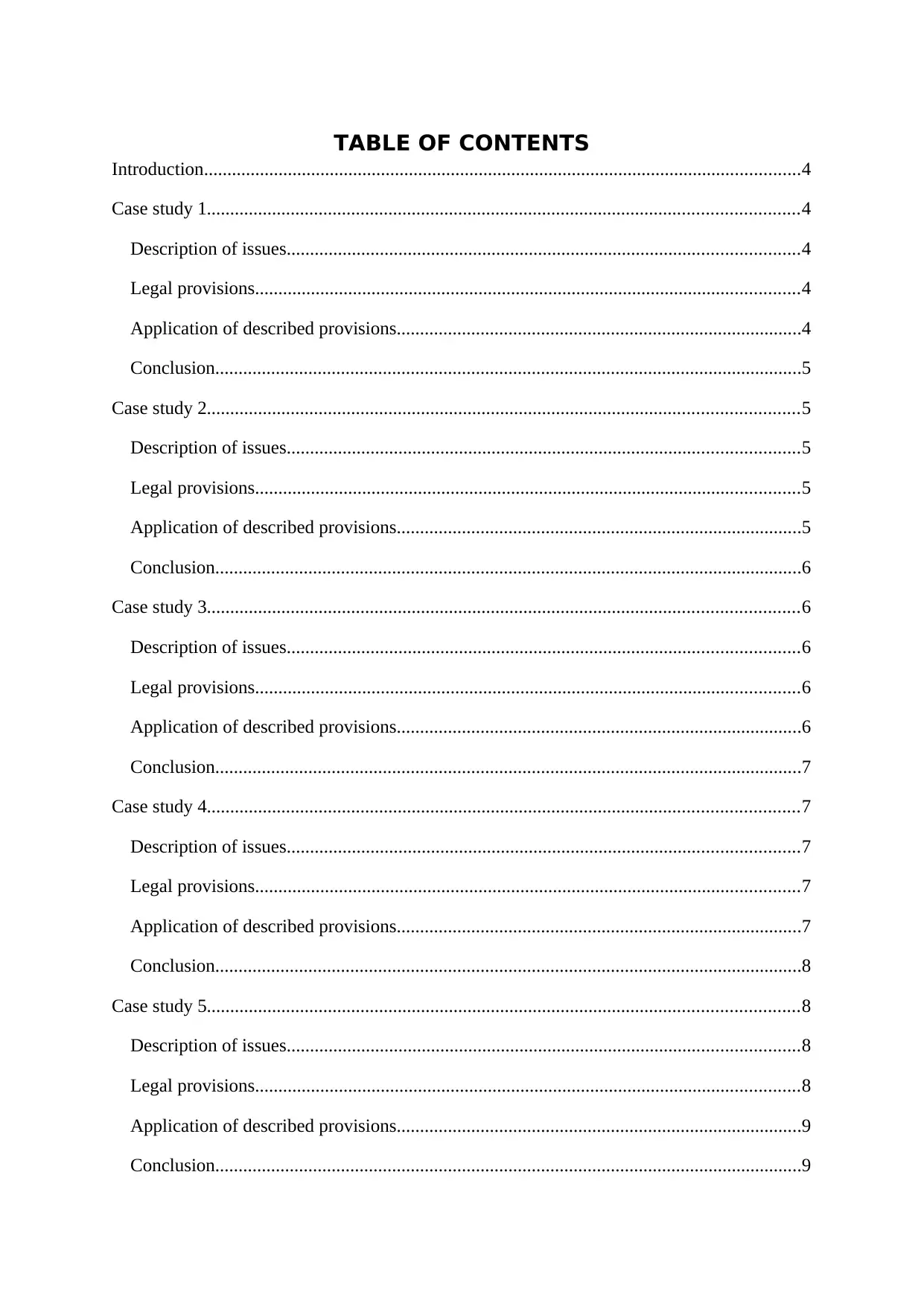
TABLE OF CONTENTS
Introduction................................................................................................................................4
Case study 1...............................................................................................................................4
Description of issues..............................................................................................................4
Legal provisions.....................................................................................................................4
Application of described provisions.......................................................................................4
Conclusion..............................................................................................................................5
Case study 2...............................................................................................................................5
Description of issues..............................................................................................................5
Legal provisions.....................................................................................................................5
Application of described provisions.......................................................................................5
Conclusion..............................................................................................................................6
Case study 3...............................................................................................................................6
Description of issues..............................................................................................................6
Legal provisions.....................................................................................................................6
Application of described provisions.......................................................................................6
Conclusion..............................................................................................................................7
Case study 4...............................................................................................................................7
Description of issues..............................................................................................................7
Legal provisions.....................................................................................................................7
Application of described provisions.......................................................................................7
Conclusion..............................................................................................................................8
Case study 5...............................................................................................................................8
Description of issues..............................................................................................................8
Legal provisions.....................................................................................................................8
Application of described provisions.......................................................................................9
Conclusion..............................................................................................................................9
Introduction................................................................................................................................4
Case study 1...............................................................................................................................4
Description of issues..............................................................................................................4
Legal provisions.....................................................................................................................4
Application of described provisions.......................................................................................4
Conclusion..............................................................................................................................5
Case study 2...............................................................................................................................5
Description of issues..............................................................................................................5
Legal provisions.....................................................................................................................5
Application of described provisions.......................................................................................5
Conclusion..............................................................................................................................6
Case study 3...............................................................................................................................6
Description of issues..............................................................................................................6
Legal provisions.....................................................................................................................6
Application of described provisions.......................................................................................6
Conclusion..............................................................................................................................7
Case study 4...............................................................................................................................7
Description of issues..............................................................................................................7
Legal provisions.....................................................................................................................7
Application of described provisions.......................................................................................7
Conclusion..............................................................................................................................8
Case study 5...............................................................................................................................8
Description of issues..............................................................................................................8
Legal provisions.....................................................................................................................8
Application of described provisions.......................................................................................9
Conclusion..............................................................................................................................9

Conclusion................................................................................................................................10
References................................................................................................................................11
References................................................................................................................................11
⊘ This is a preview!⊘
Do you want full access?
Subscribe today to unlock all pages.

Trusted by 1+ million students worldwide

LIST OF TABLES
Table 1: Other method for computation of net capital gain or loss...........................................4
Table 2: computation of net capital gain or loss by considering transactions of Eric...............4
Table 3: Statement showing computation of taxable value on which FBT will be payable......5
Table 4: Application of ruling TR 95/6 on the cited case..........................................................9
Table 1: Other method for computation of net capital gain or loss...........................................4
Table 2: computation of net capital gain or loss by considering transactions of Eric...............4
Table 3: Statement showing computation of taxable value on which FBT will be payable......5
Table 4: Application of ruling TR 95/6 on the cited case..........................................................9
Paraphrase This Document
Need a fresh take? Get an instant paraphrase of this document with our AI Paraphraser
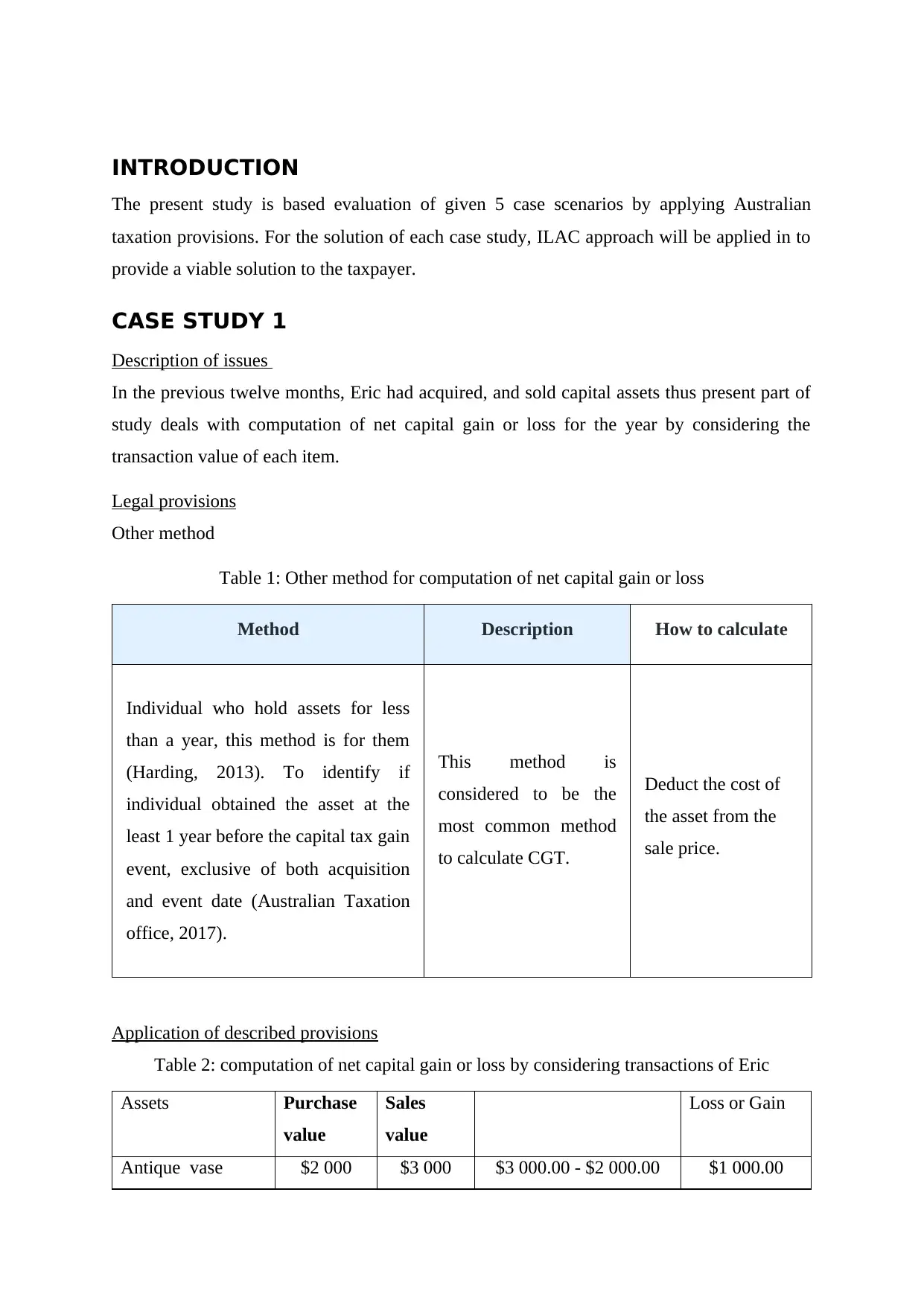
INTRODUCTION
The present study is based evaluation of given 5 case scenarios by applying Australian
taxation provisions. For the solution of each case study, ILAC approach will be applied in to
provide a viable solution to the taxpayer.
CASE STUDY 1
Description of issues
In the previous twelve months, Eric had acquired, and sold capital assets thus present part of
study deals with computation of net capital gain or loss for the year by considering the
transaction value of each item.
Legal provisions
Other method
Table 1: Other method for computation of net capital gain or loss
Method Description How to calculate
Individual who hold assets for less
than a year, this method is for them
(Harding, 2013). To identify if
individual obtained the asset at the
least 1 year before the capital tax gain
event, exclusive of both acquisition
and event date (Australian Taxation
office, 2017).
This method is
considered to be the
most common method
to calculate CGT.
Deduct the cost of
the asset from the
sale price.
Application of described provisions
Table 2: computation of net capital gain or loss by considering transactions of Eric
Assets Purchase
value
Sales
value
Loss or Gain
Antique vase $2 000 $3 000 $3 000.00 - $2 000.00 $1 000.00
The present study is based evaluation of given 5 case scenarios by applying Australian
taxation provisions. For the solution of each case study, ILAC approach will be applied in to
provide a viable solution to the taxpayer.
CASE STUDY 1
Description of issues
In the previous twelve months, Eric had acquired, and sold capital assets thus present part of
study deals with computation of net capital gain or loss for the year by considering the
transaction value of each item.
Legal provisions
Other method
Table 1: Other method for computation of net capital gain or loss
Method Description How to calculate
Individual who hold assets for less
than a year, this method is for them
(Harding, 2013). To identify if
individual obtained the asset at the
least 1 year before the capital tax gain
event, exclusive of both acquisition
and event date (Australian Taxation
office, 2017).
This method is
considered to be the
most common method
to calculate CGT.
Deduct the cost of
the asset from the
sale price.
Application of described provisions
Table 2: computation of net capital gain or loss by considering transactions of Eric
Assets Purchase
value
Sales
value
Loss or Gain
Antique vase $2 000 $3 000 $3 000.00 - $2 000.00 $1 000.00
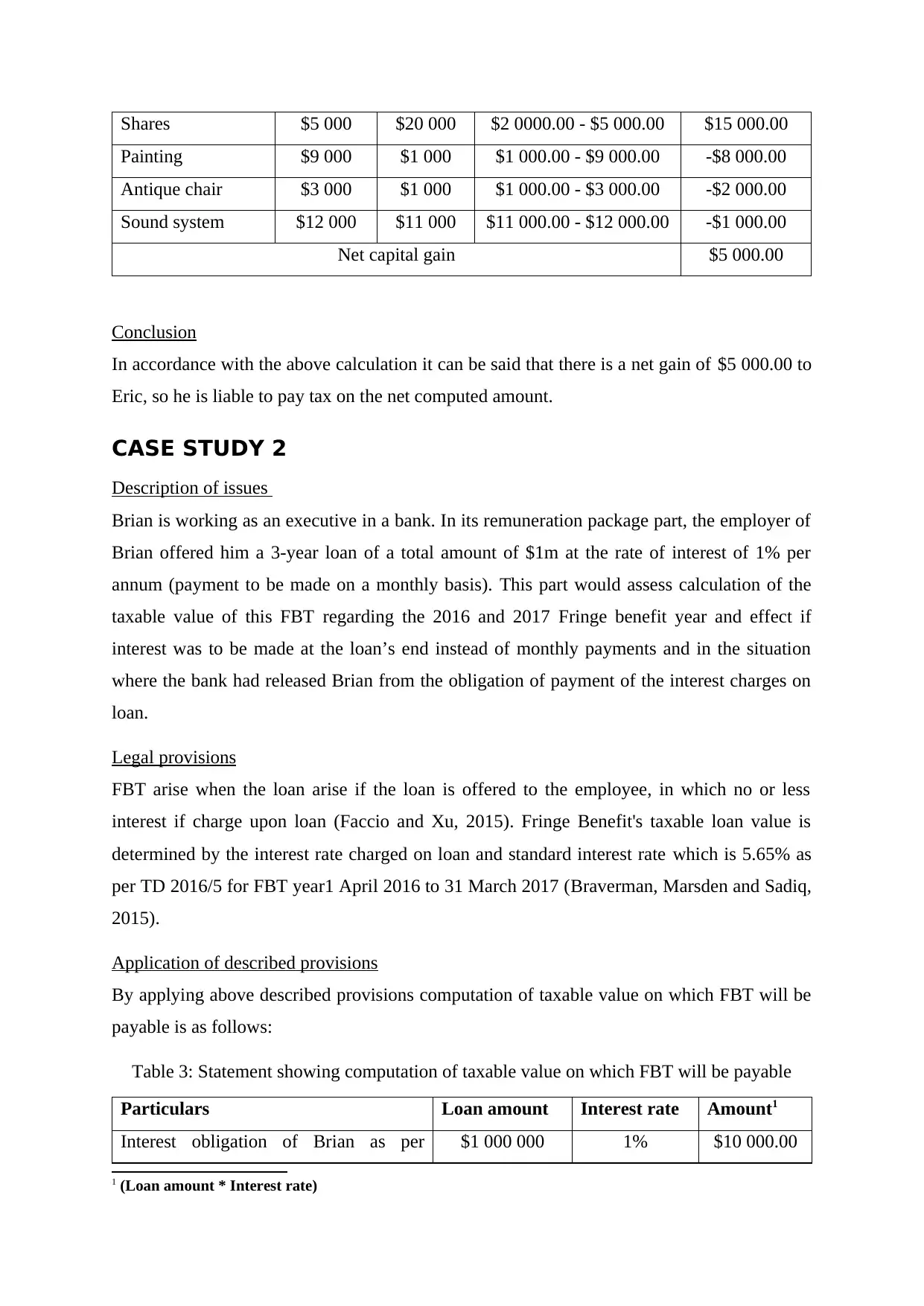
Shares $5 000 $20 000 $2 0000.00 - $5 000.00 $15 000.00
Painting $9 000 $1 000 $1 000.00 - $9 000.00 -$8 000.00
Antique chair $3 000 $1 000 $1 000.00 - $3 000.00 -$2 000.00
Sound system $12 000 $11 000 $11 000.00 - $12 000.00 -$1 000.00
Net capital gain $5 000.00
Conclusion
In accordance with the above calculation it can be said that there is a net gain of $5 000.00 to
Eric, so he is liable to pay tax on the net computed amount.
CASE STUDY 2
Description of issues
Brian is working as an executive in a bank. In its remuneration package part, the employer of
Brian offered him a 3-year loan of a total amount of $1m at the rate of interest of 1% per
annum (payment to be made on a monthly basis). This part would assess calculation of the
taxable value of this FBT regarding the 2016 and 2017 Fringe benefit year and effect if
interest was to be made at the loan’s end instead of monthly payments and in the situation
where the bank had released Brian from the obligation of payment of the interest charges on
loan.
Legal provisions
FBT arise when the loan arise if the loan is offered to the employee, in which no or less
interest if charge upon loan (Faccio and Xu, 2015). Fringe Benefit's taxable loan value is
determined by the interest rate charged on loan and standard interest rate which is 5.65% as
per TD 2016/5 for FBT year1 April 2016 to 31 March 2017 (Braverman, Marsden and Sadiq,
2015).
Application of described provisions
By applying above described provisions computation of taxable value on which FBT will be
payable is as follows:
Table 3: Statement showing computation of taxable value on which FBT will be payable
Particulars Loan amount Interest rate Amount1
Interest obligation of Brian as per $1 000 000 1% $10 000.00
1 (Loan amount * Interest rate)
Painting $9 000 $1 000 $1 000.00 - $9 000.00 -$8 000.00
Antique chair $3 000 $1 000 $1 000.00 - $3 000.00 -$2 000.00
Sound system $12 000 $11 000 $11 000.00 - $12 000.00 -$1 000.00
Net capital gain $5 000.00
Conclusion
In accordance with the above calculation it can be said that there is a net gain of $5 000.00 to
Eric, so he is liable to pay tax on the net computed amount.
CASE STUDY 2
Description of issues
Brian is working as an executive in a bank. In its remuneration package part, the employer of
Brian offered him a 3-year loan of a total amount of $1m at the rate of interest of 1% per
annum (payment to be made on a monthly basis). This part would assess calculation of the
taxable value of this FBT regarding the 2016 and 2017 Fringe benefit year and effect if
interest was to be made at the loan’s end instead of monthly payments and in the situation
where the bank had released Brian from the obligation of payment of the interest charges on
loan.
Legal provisions
FBT arise when the loan arise if the loan is offered to the employee, in which no or less
interest if charge upon loan (Faccio and Xu, 2015). Fringe Benefit's taxable loan value is
determined by the interest rate charged on loan and standard interest rate which is 5.65% as
per TD 2016/5 for FBT year1 April 2016 to 31 March 2017 (Braverman, Marsden and Sadiq,
2015).
Application of described provisions
By applying above described provisions computation of taxable value on which FBT will be
payable is as follows:
Table 3: Statement showing computation of taxable value on which FBT will be payable
Particulars Loan amount Interest rate Amount1
Interest obligation of Brian as per $1 000 000 1% $10 000.00
1 (Loan amount * Interest rate)
⊘ This is a preview!⊘
Do you want full access?
Subscribe today to unlock all pages.

Trusted by 1+ million students worldwide
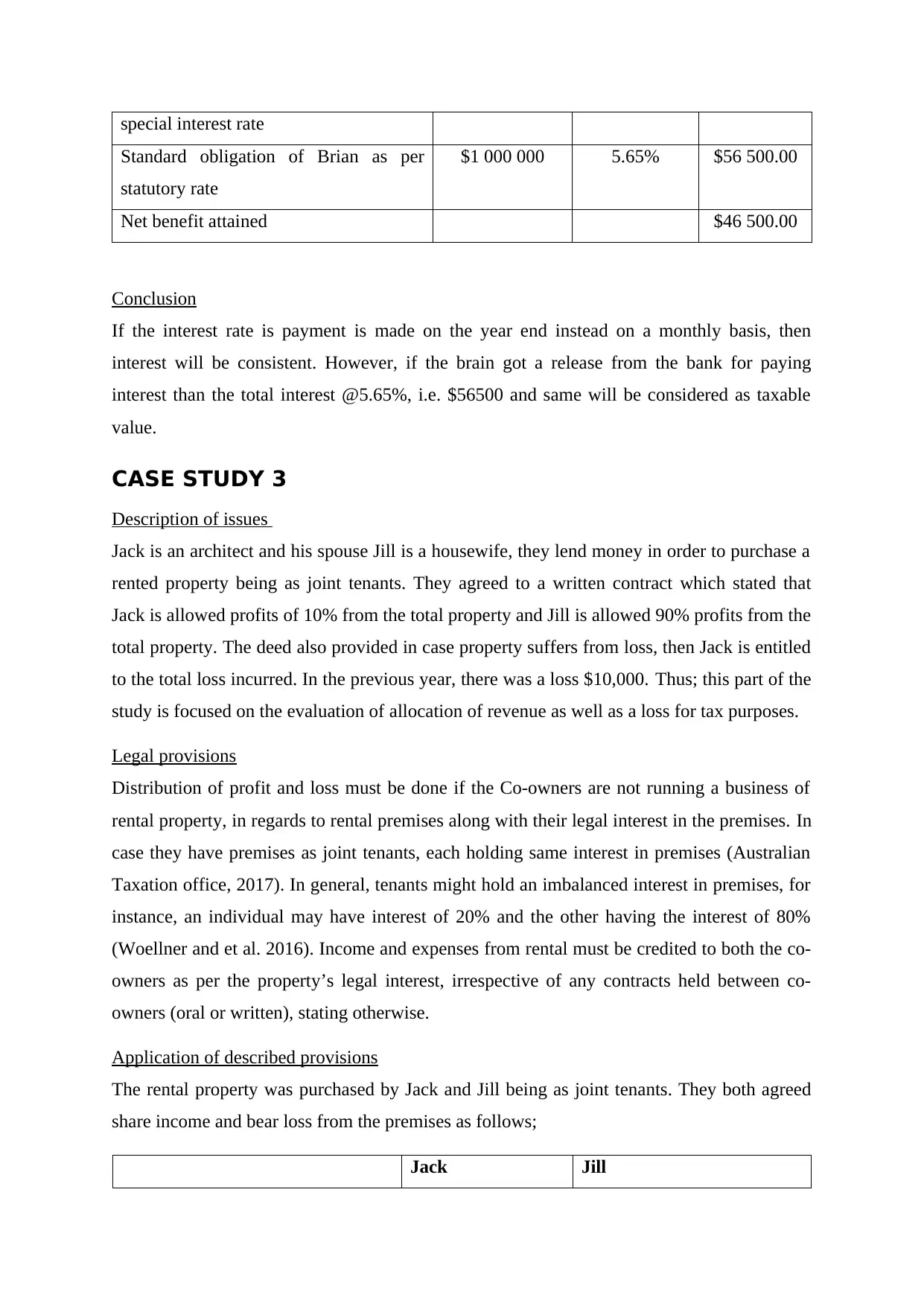
special interest rate
Standard obligation of Brian as per
statutory rate
$1 000 000 5.65% $56 500.00
Net benefit attained $46 500.00
Conclusion
If the interest rate is payment is made on the year end instead on a monthly basis, then
interest will be consistent. However, if the brain got a release from the bank for paying
interest than the total interest @5.65%, i.e. $56500 and same will be considered as taxable
value.
CASE STUDY 3
Description of issues
Jack is an architect and his spouse Jill is a housewife, they lend money in order to purchase a
rented property being as joint tenants. They agreed to a written contract which stated that
Jack is allowed profits of 10% from the total property and Jill is allowed 90% profits from the
total property. The deed also provided in case property suffers from loss, then Jack is entitled
to the total loss incurred. In the previous year, there was a loss $10,000. Thus; this part of the
study is focused on the evaluation of allocation of revenue as well as a loss for tax purposes.
Legal provisions
Distribution of profit and loss must be done if the Co-owners are not running a business of
rental property, in regards to rental premises along with their legal interest in the premises. In
case they have premises as joint tenants, each holding same interest in premises (Australian
Taxation office, 2017). In general, tenants might hold an imbalanced interest in premises, for
instance, an individual may have interest of 20% and the other having the interest of 80%
(Woellner and et al. 2016). Income and expenses from rental must be credited to both the co-
owners as per the property’s legal interest, irrespective of any contracts held between co-
owners (oral or written), stating otherwise.
Application of described provisions
The rental property was purchased by Jack and Jill being as joint tenants. They both agreed
share income and bear loss from the premises as follows;
Jack Jill
Standard obligation of Brian as per
statutory rate
$1 000 000 5.65% $56 500.00
Net benefit attained $46 500.00
Conclusion
If the interest rate is payment is made on the year end instead on a monthly basis, then
interest will be consistent. However, if the brain got a release from the bank for paying
interest than the total interest @5.65%, i.e. $56500 and same will be considered as taxable
value.
CASE STUDY 3
Description of issues
Jack is an architect and his spouse Jill is a housewife, they lend money in order to purchase a
rented property being as joint tenants. They agreed to a written contract which stated that
Jack is allowed profits of 10% from the total property and Jill is allowed 90% profits from the
total property. The deed also provided in case property suffers from loss, then Jack is entitled
to the total loss incurred. In the previous year, there was a loss $10,000. Thus; this part of the
study is focused on the evaluation of allocation of revenue as well as a loss for tax purposes.
Legal provisions
Distribution of profit and loss must be done if the Co-owners are not running a business of
rental property, in regards to rental premises along with their legal interest in the premises. In
case they have premises as joint tenants, each holding same interest in premises (Australian
Taxation office, 2017). In general, tenants might hold an imbalanced interest in premises, for
instance, an individual may have interest of 20% and the other having the interest of 80%
(Woellner and et al. 2016). Income and expenses from rental must be credited to both the co-
owners as per the property’s legal interest, irrespective of any contracts held between co-
owners (oral or written), stating otherwise.
Application of described provisions
The rental property was purchased by Jack and Jill being as joint tenants. They both agreed
share income and bear loss from the premises as follows;
Jack Jill
Paraphrase This Document
Need a fresh take? Get an instant paraphrase of this document with our AI Paraphraser
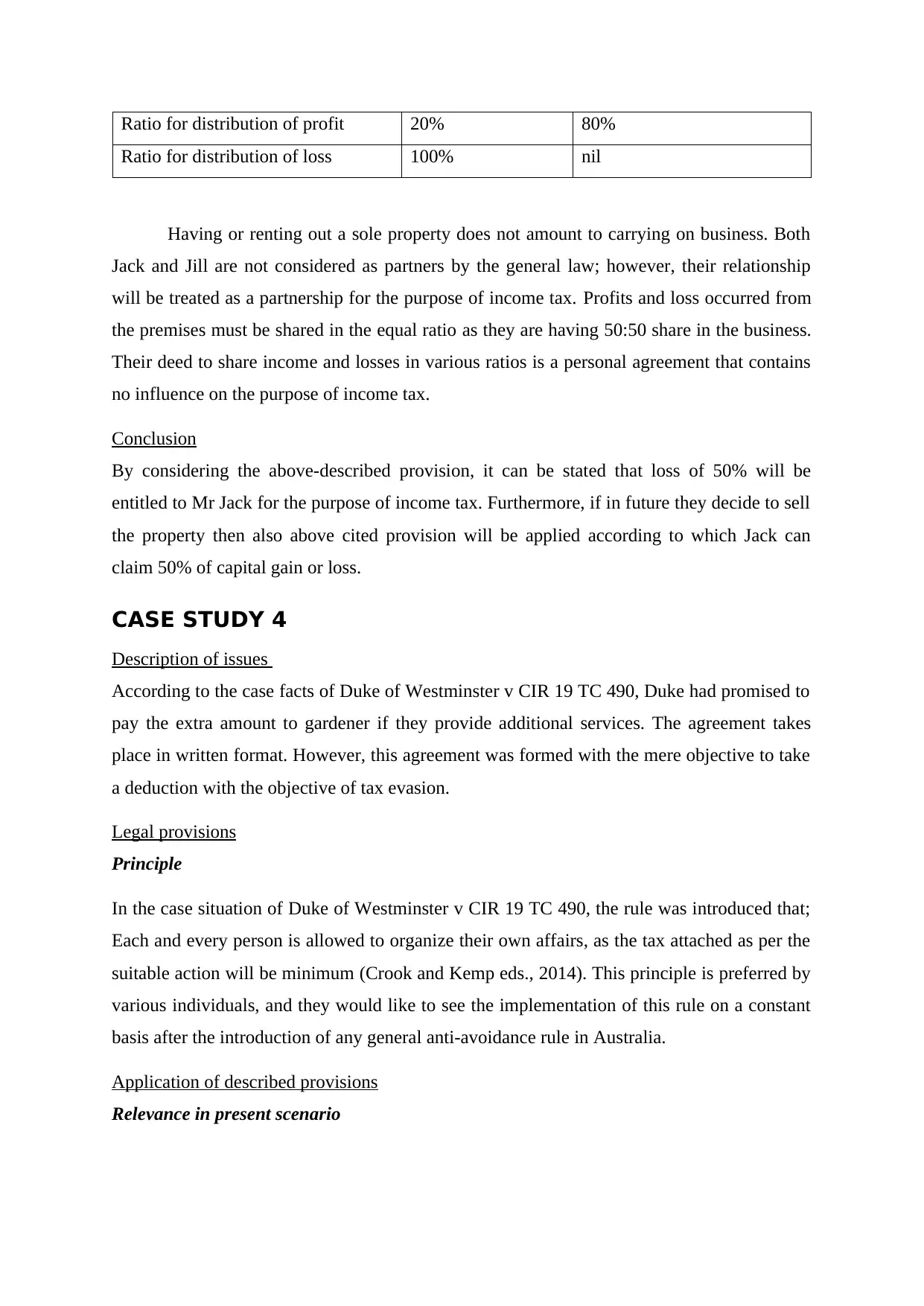
Ratio for distribution of profit 20% 80%
Ratio for distribution of loss 100% nil
Having or renting out a sole property does not amount to carrying on business. Both
Jack and Jill are not considered as partners by the general law; however, their relationship
will be treated as a partnership for the purpose of income tax. Profits and loss occurred from
the premises must be shared in the equal ratio as they are having 50:50 share in the business.
Their deed to share income and losses in various ratios is a personal agreement that contains
no influence on the purpose of income tax.
Conclusion
By considering the above-described provision, it can be stated that loss of 50% will be
entitled to Mr Jack for the purpose of income tax. Furthermore, if in future they decide to sell
the property then also above cited provision will be applied according to which Jack can
claim 50% of capital gain or loss.
CASE STUDY 4
Description of issues
According to the case facts of Duke of Westminster v CIR 19 TC 490, Duke had promised to
pay the extra amount to gardener if they provide additional services. The agreement takes
place in written format. However, this agreement was formed with the mere objective to take
a deduction with the objective of tax evasion.
Legal provisions
Principle
In the case situation of Duke of Westminster v CIR 19 TC 490, the rule was introduced that;
Each and every person is allowed to organize their own affairs, as the tax attached as per the
suitable action will be minimum (Crook and Kemp eds., 2014). This principle is preferred by
various individuals, and they would like to see the implementation of this rule on a constant
basis after the introduction of any general anti-avoidance rule in Australia.
Application of described provisions
Relevance in present scenario
Ratio for distribution of loss 100% nil
Having or renting out a sole property does not amount to carrying on business. Both
Jack and Jill are not considered as partners by the general law; however, their relationship
will be treated as a partnership for the purpose of income tax. Profits and loss occurred from
the premises must be shared in the equal ratio as they are having 50:50 share in the business.
Their deed to share income and losses in various ratios is a personal agreement that contains
no influence on the purpose of income tax.
Conclusion
By considering the above-described provision, it can be stated that loss of 50% will be
entitled to Mr Jack for the purpose of income tax. Furthermore, if in future they decide to sell
the property then also above cited provision will be applied according to which Jack can
claim 50% of capital gain or loss.
CASE STUDY 4
Description of issues
According to the case facts of Duke of Westminster v CIR 19 TC 490, Duke had promised to
pay the extra amount to gardener if they provide additional services. The agreement takes
place in written format. However, this agreement was formed with the mere objective to take
a deduction with the objective of tax evasion.
Legal provisions
Principle
In the case situation of Duke of Westminster v CIR 19 TC 490, the rule was introduced that;
Each and every person is allowed to organize their own affairs, as the tax attached as per the
suitable action will be minimum (Crook and Kemp eds., 2014). This principle is preferred by
various individuals, and they would like to see the implementation of this rule on a constant
basis after the introduction of any general anti-avoidance rule in Australia.
Application of described provisions
Relevance in present scenario
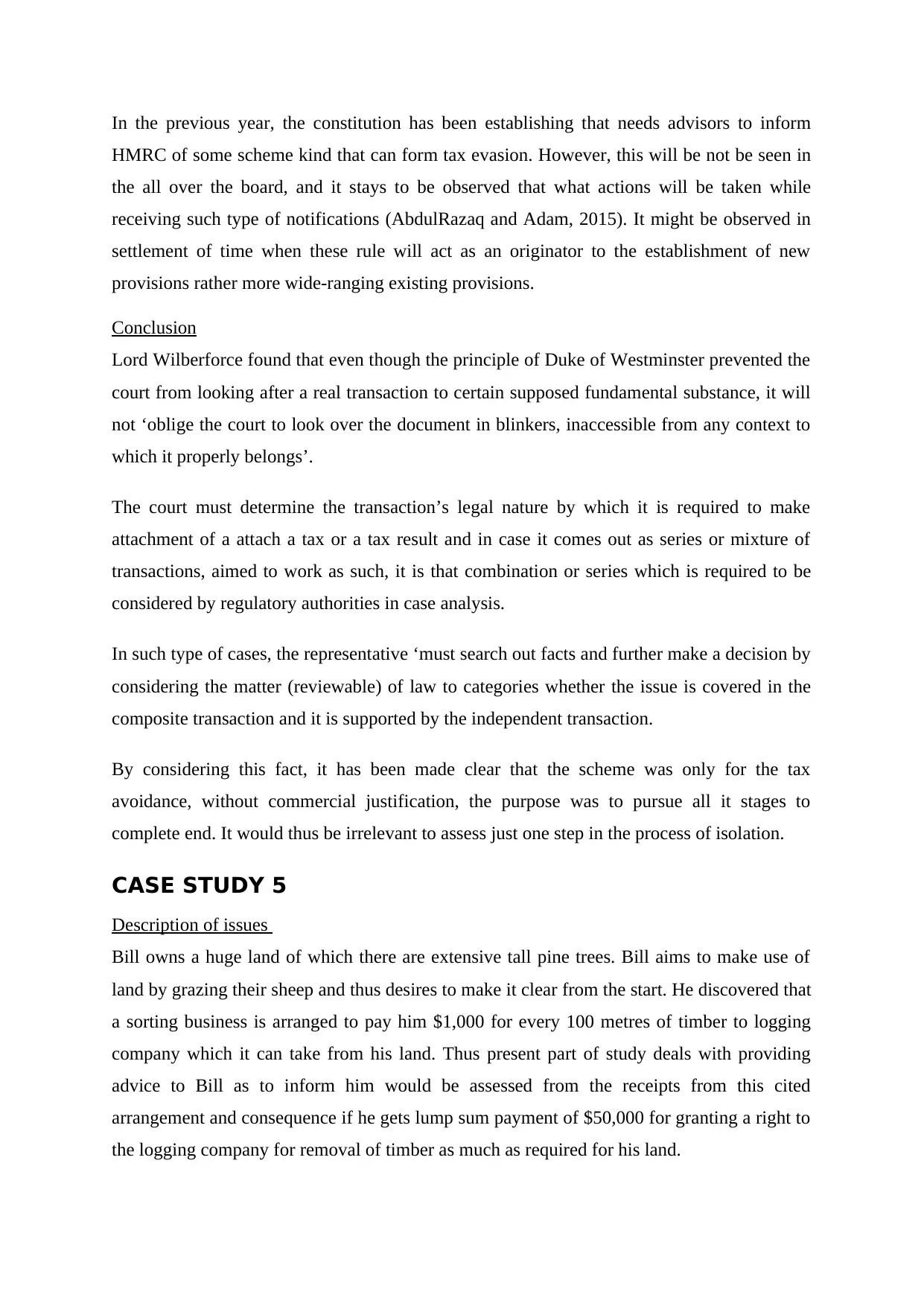
In the previous year, the constitution has been establishing that needs advisors to inform
HMRC of some scheme kind that can form tax evasion. However, this will be not be seen in
the all over the board, and it stays to be observed that what actions will be taken while
receiving such type of notifications (AbdulRazaq and Adam, 2015). It might be observed in
settlement of time when these rule will act as an originator to the establishment of new
provisions rather more wide-ranging existing provisions.
Conclusion
Lord Wilberforce found that even though the principle of Duke of Westminster prevented the
court from looking after a real transaction to certain supposed fundamental substance, it will
not ‘oblige the court to look over the document in blinkers, inaccessible from any context to
which it properly belongs’.
The court must determine the transaction’s legal nature by which it is required to make
attachment of a attach a tax or a tax result and in case it comes out as series or mixture of
transactions, aimed to work as such, it is that combination or series which is required to be
considered by regulatory authorities in case analysis.
In such type of cases, the representative ‘must search out facts and further make a decision by
considering the matter (reviewable) of law to categories whether the issue is covered in the
composite transaction and it is supported by the independent transaction.
By considering this fact, it has been made clear that the scheme was only for the tax
avoidance, without commercial justification, the purpose was to pursue all it stages to
complete end. It would thus be irrelevant to assess just one step in the process of isolation.
CASE STUDY 5
Description of issues
Bill owns a huge land of which there are extensive tall pine trees. Bill aims to make use of
land by grazing their sheep and thus desires to make it clear from the start. He discovered that
a sorting business is arranged to pay him $1,000 for every 100 metres of timber to logging
company which it can take from his land. Thus present part of study deals with providing
advice to Bill as to inform him would be assessed from the receipts from this cited
arrangement and consequence if he gets lump sum payment of $50,000 for granting a right to
the logging company for removal of timber as much as required for his land.
HMRC of some scheme kind that can form tax evasion. However, this will be not be seen in
the all over the board, and it stays to be observed that what actions will be taken while
receiving such type of notifications (AbdulRazaq and Adam, 2015). It might be observed in
settlement of time when these rule will act as an originator to the establishment of new
provisions rather more wide-ranging existing provisions.
Conclusion
Lord Wilberforce found that even though the principle of Duke of Westminster prevented the
court from looking after a real transaction to certain supposed fundamental substance, it will
not ‘oblige the court to look over the document in blinkers, inaccessible from any context to
which it properly belongs’.
The court must determine the transaction’s legal nature by which it is required to make
attachment of a attach a tax or a tax result and in case it comes out as series or mixture of
transactions, aimed to work as such, it is that combination or series which is required to be
considered by regulatory authorities in case analysis.
In such type of cases, the representative ‘must search out facts and further make a decision by
considering the matter (reviewable) of law to categories whether the issue is covered in the
composite transaction and it is supported by the independent transaction.
By considering this fact, it has been made clear that the scheme was only for the tax
avoidance, without commercial justification, the purpose was to pursue all it stages to
complete end. It would thus be irrelevant to assess just one step in the process of isolation.
CASE STUDY 5
Description of issues
Bill owns a huge land of which there are extensive tall pine trees. Bill aims to make use of
land by grazing their sheep and thus desires to make it clear from the start. He discovered that
a sorting business is arranged to pay him $1,000 for every 100 metres of timber to logging
company which it can take from his land. Thus present part of study deals with providing
advice to Bill as to inform him would be assessed from the receipts from this cited
arrangement and consequence if he gets lump sum payment of $50,000 for granting a right to
the logging company for removal of timber as much as required for his land.
⊘ This is a preview!⊘
Do you want full access?
Subscribe today to unlock all pages.

Trusted by 1+ million students worldwide
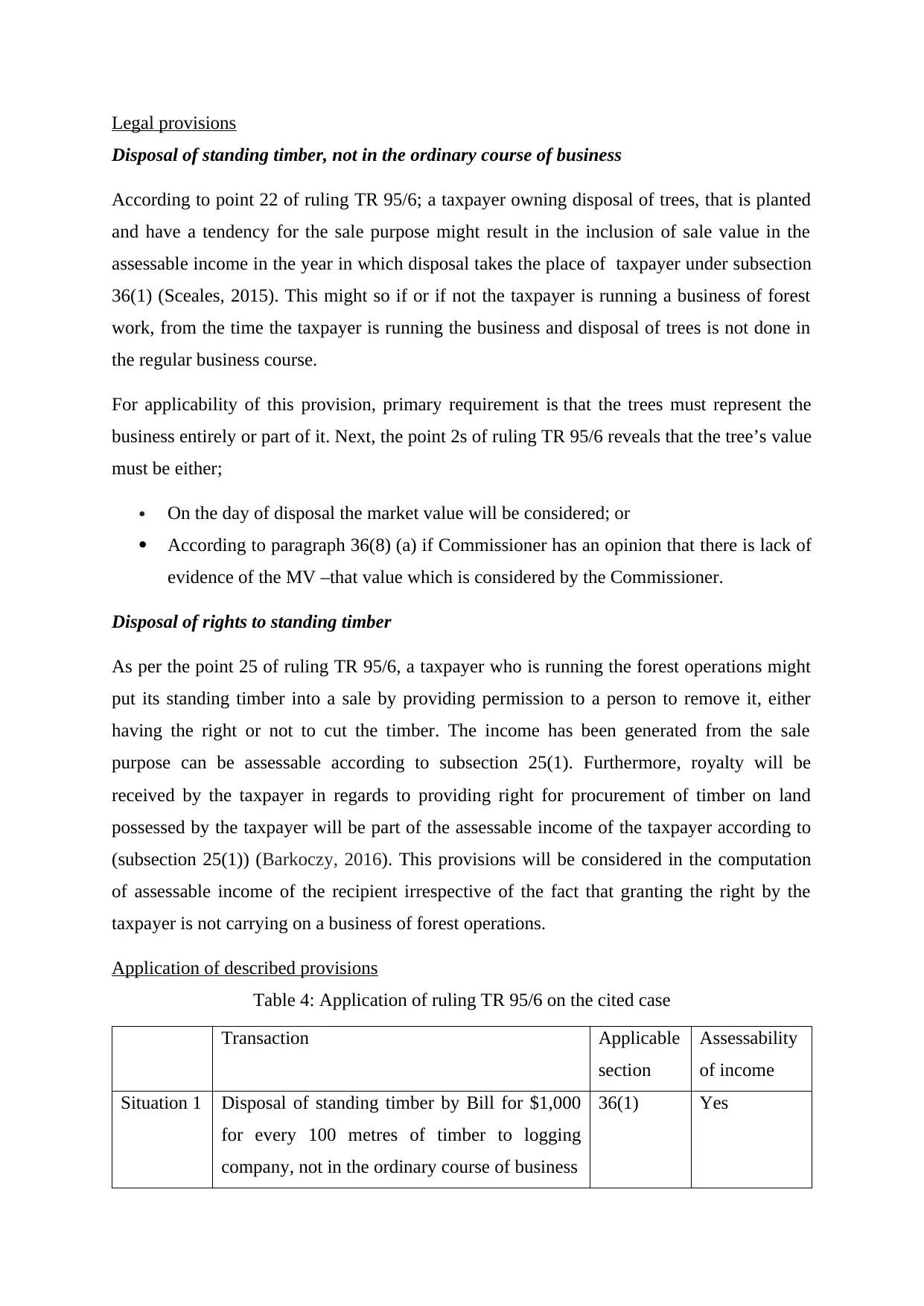
Legal provisions
Disposal of standing timber, not in the ordinary course of business
According to point 22 of ruling TR 95/6; a taxpayer owning disposal of trees, that is planted
and have a tendency for the sale purpose might result in the inclusion of sale value in the
assessable income in the year in which disposal takes the place of taxpayer under subsection
36(1) (Sceales, 2015). This might so if or if not the taxpayer is running a business of forest
work, from the time the taxpayer is running the business and disposal of trees is not done in
the regular business course.
For applicability of this provision, primary requirement is that the trees must represent the
business entirely or part of it. Next, the point 2s of ruling TR 95/6 reveals that the tree’s value
must be either;
On the day of disposal the market value will be considered; or
According to paragraph 36(8) (a) if Commissioner has an opinion that there is lack of
evidence of the MV –that value which is considered by the Commissioner.
Disposal of rights to standing timber
As per the point 25 of ruling TR 95/6, a taxpayer who is running the forest operations might
put its standing timber into a sale by providing permission to a person to remove it, either
having the right or not to cut the timber. The income has been generated from the sale
purpose can be assessable according to subsection 25(1). Furthermore, royalty will be
received by the taxpayer in regards to providing right for procurement of timber on land
possessed by the taxpayer will be part of the assessable income of the taxpayer according to
(subsection 25(1)) (Barkoczy, 2016). This provisions will be considered in the computation
of assessable income of the recipient irrespective of the fact that granting the right by the
taxpayer is not carrying on a business of forest operations.
Application of described provisions
Table 4: Application of ruling TR 95/6 on the cited case
Transaction Applicable
section
Assessability
of income
Situation 1 Disposal of standing timber by Bill for $1,000
for every 100 metres of timber to logging
company, not in the ordinary course of business
36(1) Yes
Disposal of standing timber, not in the ordinary course of business
According to point 22 of ruling TR 95/6; a taxpayer owning disposal of trees, that is planted
and have a tendency for the sale purpose might result in the inclusion of sale value in the
assessable income in the year in which disposal takes the place of taxpayer under subsection
36(1) (Sceales, 2015). This might so if or if not the taxpayer is running a business of forest
work, from the time the taxpayer is running the business and disposal of trees is not done in
the regular business course.
For applicability of this provision, primary requirement is that the trees must represent the
business entirely or part of it. Next, the point 2s of ruling TR 95/6 reveals that the tree’s value
must be either;
On the day of disposal the market value will be considered; or
According to paragraph 36(8) (a) if Commissioner has an opinion that there is lack of
evidence of the MV –that value which is considered by the Commissioner.
Disposal of rights to standing timber
As per the point 25 of ruling TR 95/6, a taxpayer who is running the forest operations might
put its standing timber into a sale by providing permission to a person to remove it, either
having the right or not to cut the timber. The income has been generated from the sale
purpose can be assessable according to subsection 25(1). Furthermore, royalty will be
received by the taxpayer in regards to providing right for procurement of timber on land
possessed by the taxpayer will be part of the assessable income of the taxpayer according to
(subsection 25(1)) (Barkoczy, 2016). This provisions will be considered in the computation
of assessable income of the recipient irrespective of the fact that granting the right by the
taxpayer is not carrying on a business of forest operations.
Application of described provisions
Table 4: Application of ruling TR 95/6 on the cited case
Transaction Applicable
section
Assessability
of income
Situation 1 Disposal of standing timber by Bill for $1,000
for every 100 metres of timber to logging
company, not in the ordinary course of business
36(1) Yes
Paraphrase This Document
Need a fresh take? Get an instant paraphrase of this document with our AI Paraphraser
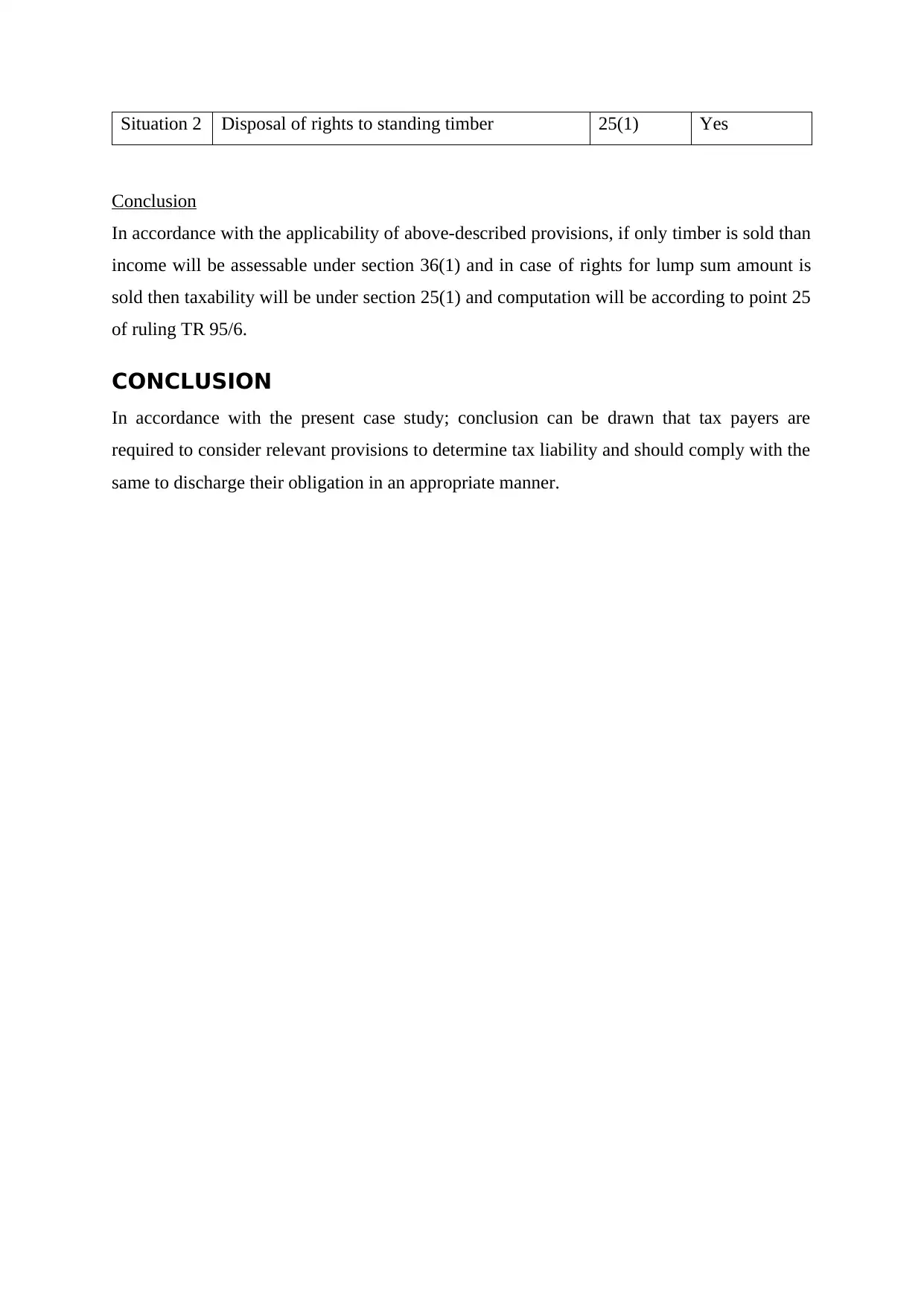
Situation 2 Disposal of rights to standing timber 25(1) Yes
Conclusion
In accordance with the applicability of above-described provisions, if only timber is sold than
income will be assessable under section 36(1) and in case of rights for lump sum amount is
sold then taxability will be under section 25(1) and computation will be according to point 25
of ruling TR 95/6.
CONCLUSION
In accordance with the present case study; conclusion can be drawn that tax payers are
required to consider relevant provisions to determine tax liability and should comply with the
same to discharge their obligation in an appropriate manner.
Conclusion
In accordance with the applicability of above-described provisions, if only timber is sold than
income will be assessable under section 36(1) and in case of rights for lump sum amount is
sold then taxability will be under section 25(1) and computation will be according to point 25
of ruling TR 95/6.
CONCLUSION
In accordance with the present case study; conclusion can be drawn that tax payers are
required to consider relevant provisions to determine tax liability and should comply with the
same to discharge their obligation in an appropriate manner.
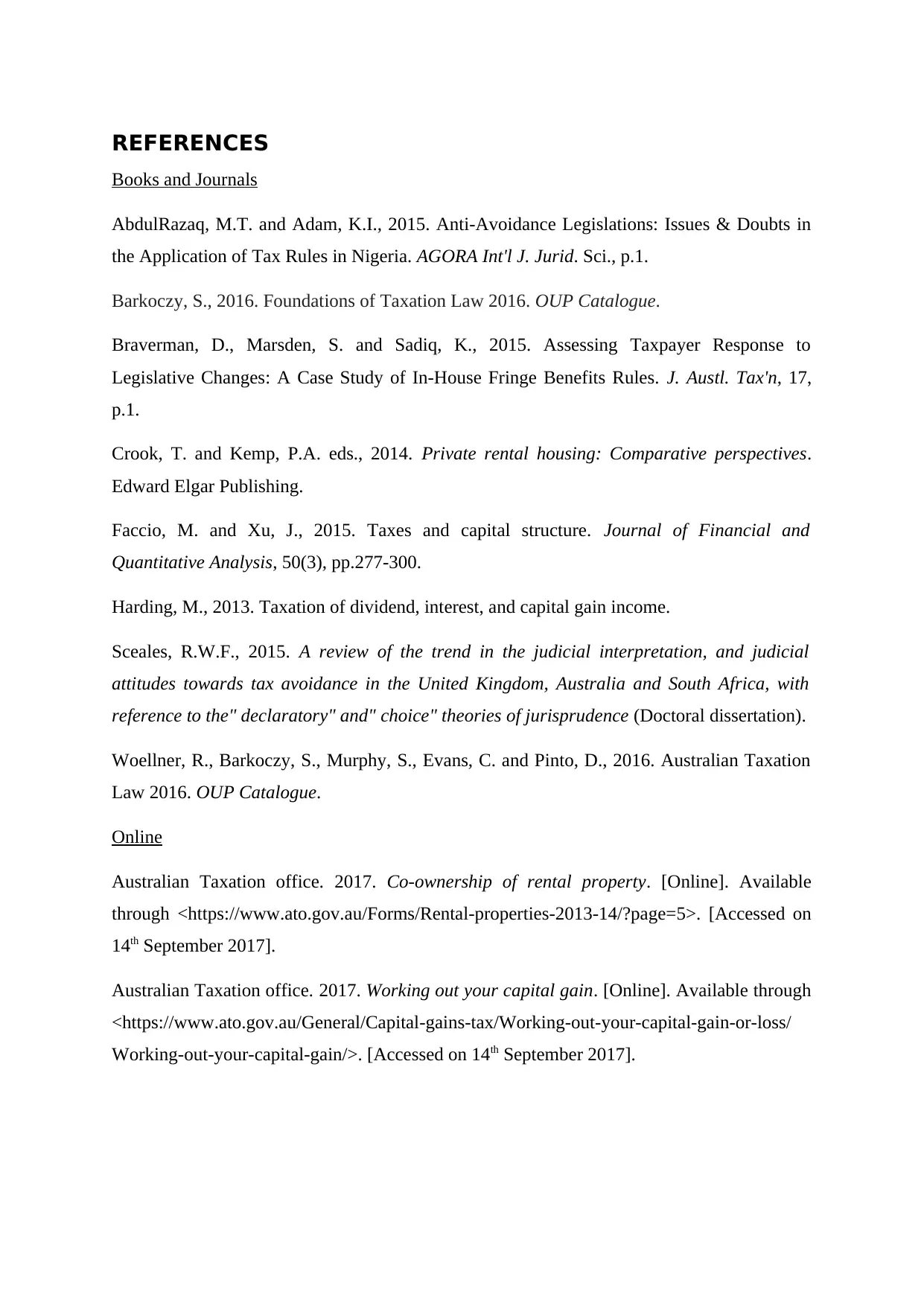
REFERENCES
Books and Journals
AbdulRazaq, M.T. and Adam, K.I., 2015. Anti-Avoidance Legislations: Issues & Doubts in
the Application of Tax Rules in Nigeria. AGORA Int'l J. Jurid. Sci., p.1.
Barkoczy, S., 2016. Foundations of Taxation Law 2016. OUP Catalogue.
Braverman, D., Marsden, S. and Sadiq, K., 2015. Assessing Taxpayer Response to
Legislative Changes: A Case Study of In-House Fringe Benefits Rules. J. Austl. Tax'n, 17,
p.1.
Crook, T. and Kemp, P.A. eds., 2014. Private rental housing: Comparative perspectives.
Edward Elgar Publishing.
Faccio, M. and Xu, J., 2015. Taxes and capital structure. Journal of Financial and
Quantitative Analysis, 50(3), pp.277-300.
Harding, M., 2013. Taxation of dividend, interest, and capital gain income.
Sceales, R.W.F., 2015. A review of the trend in the judicial interpretation, and judicial
attitudes towards tax avoidance in the United Kingdom, Australia and South Africa, with
reference to the" declaratory" and" choice" theories of jurisprudence (Doctoral dissertation).
Woellner, R., Barkoczy, S., Murphy, S., Evans, C. and Pinto, D., 2016. Australian Taxation
Law 2016. OUP Catalogue.
Online
Australian Taxation office. 2017. Co-ownership of rental property. [Online]. Available
through <https://www.ato.gov.au/Forms/Rental-properties-2013-14/?page=5>. [Accessed on
14th September 2017].
Australian Taxation office. 2017. Working out your capital gain. [Online]. Available through
<https://www.ato.gov.au/General/Capital-gains-tax/Working-out-your-capital-gain-or-loss/
Working-out-your-capital-gain/>. [Accessed on 14th September 2017].
Books and Journals
AbdulRazaq, M.T. and Adam, K.I., 2015. Anti-Avoidance Legislations: Issues & Doubts in
the Application of Tax Rules in Nigeria. AGORA Int'l J. Jurid. Sci., p.1.
Barkoczy, S., 2016. Foundations of Taxation Law 2016. OUP Catalogue.
Braverman, D., Marsden, S. and Sadiq, K., 2015. Assessing Taxpayer Response to
Legislative Changes: A Case Study of In-House Fringe Benefits Rules. J. Austl. Tax'n, 17,
p.1.
Crook, T. and Kemp, P.A. eds., 2014. Private rental housing: Comparative perspectives.
Edward Elgar Publishing.
Faccio, M. and Xu, J., 2015. Taxes and capital structure. Journal of Financial and
Quantitative Analysis, 50(3), pp.277-300.
Harding, M., 2013. Taxation of dividend, interest, and capital gain income.
Sceales, R.W.F., 2015. A review of the trend in the judicial interpretation, and judicial
attitudes towards tax avoidance in the United Kingdom, Australia and South Africa, with
reference to the" declaratory" and" choice" theories of jurisprudence (Doctoral dissertation).
Woellner, R., Barkoczy, S., Murphy, S., Evans, C. and Pinto, D., 2016. Australian Taxation
Law 2016. OUP Catalogue.
Online
Australian Taxation office. 2017. Co-ownership of rental property. [Online]. Available
through <https://www.ato.gov.au/Forms/Rental-properties-2013-14/?page=5>. [Accessed on
14th September 2017].
Australian Taxation office. 2017. Working out your capital gain. [Online]. Available through
<https://www.ato.gov.au/General/Capital-gains-tax/Working-out-your-capital-gain-or-loss/
Working-out-your-capital-gain/>. [Accessed on 14th September 2017].
⊘ This is a preview!⊘
Do you want full access?
Subscribe today to unlock all pages.

Trusted by 1+ million students worldwide
1 out of 12
Related Documents
Your All-in-One AI-Powered Toolkit for Academic Success.
+13062052269
info@desklib.com
Available 24*7 on WhatsApp / Email
![[object Object]](/_next/static/media/star-bottom.7253800d.svg)
Unlock your academic potential
Copyright © 2020–2025 A2Z Services. All Rights Reserved. Developed and managed by ZUCOL.





